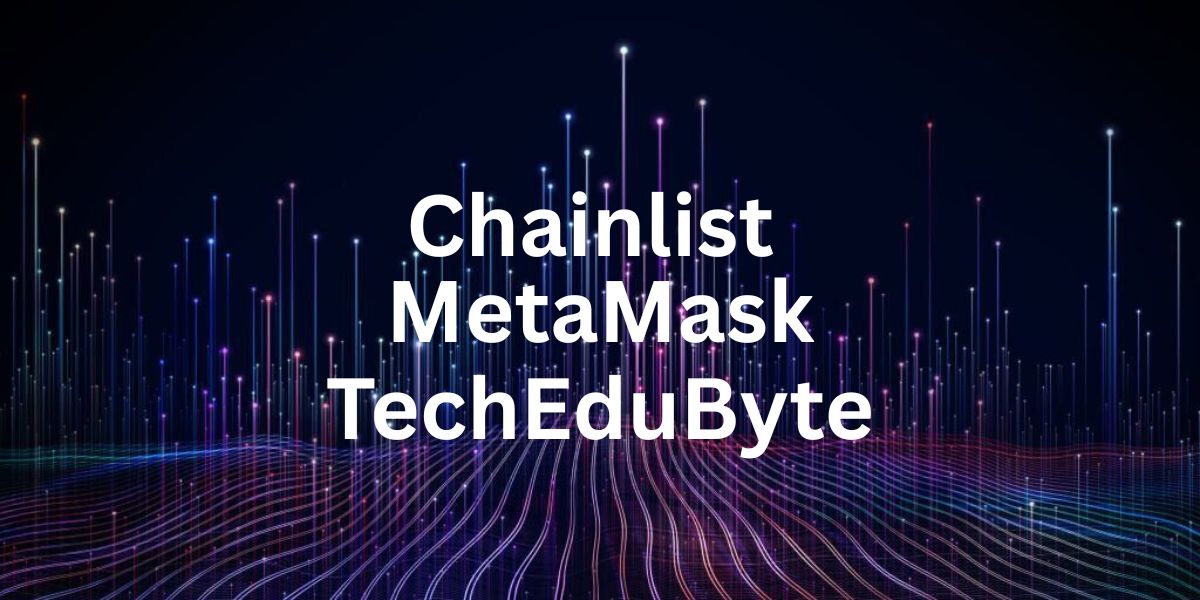Chainlist MetaMask TechEduByte: Your Ultimate Guide to Blockchain Network Management

The blockchain ecosystem has evolved dramatically over the past few years, with multiple networks emerging to serve different purposes and communities. As decentralized applications (dApps) continue to proliferate across various blockchain networks, users often find themselves needing to switch between different chains to access specific services, tokens, or applications. This is where chainlist metamask techedubyte becomes an invaluable resource for crypto enthusiasts and DeFi users.
Understanding how to efficiently manage multiple blockchain networks in your MetaMask wallet is crucial for navigating the modern crypto landscape. Whether you’re a seasoned trader looking to access new DeFi protocols on emerging chains or a newcomer trying to understand how different networks work together, mastering the integration between Chainlist and MetaMask through platforms like TechEduByte will significantly enhance your blockchain experience.
Understanding Chainlist: The Network Directory Revolution
Chainlist represents a revolutionary approach to blockchain network management, serving as a comprehensive directory of EVM-compatible networks that users can easily add to their MetaMask wallets. This open-source project has become the go-to resource for discovering and connecting to various blockchain networks, from major players like Polygon and Arbitrum to emerging layer-2 solutions and specialized chains.
The platform operates on a simple yet powerful premise: providing users with accurate, up-to-date network configuration details that can be added to MetaMask with just a few clicks. Before Chainlist existed, users had to manually research and input network details, including RPC URLs, chain IDs, currency symbols, and block explorer links. This process was not only time-consuming but also prone to errors that could result in failed transactions or security vulnerabilities.
What makes chainlist metamask techedubyte particularly valuable is its role in democratizing access to the multi-chain ecosystem. The platform maintains detailed information about hundreds of blockchain networks, including testnets for developers and specialized chains for specific use cases like gaming, NFTs, or enterprise applications. Each network listing includes essential technical details such as RPC endpoints, native currency information, and links to block explorers, ensuring users have all the information they need to interact safely with different chains.
The community-driven nature of Chainlist ensures that network information remains current and accurate. Contributors regularly update listings to reflect changes in network infrastructure, new RPC endpoints, or modifications to network parameters. This collaborative approach has made Chainlist an indispensable tool for the blockchain community, particularly when combined with educational resources from platforms like TechEduByte.
MetaMask Integration: Seamless Multi-Chain Experience
MetaMask, as the world’s leading Web3 wallet, has become synonymous with blockchain interaction for millions of users worldwide. Its browser extension and mobile applications provide a secure gateway to decentralized applications, token management, and cross-chain interactions. However, MetaMask’s true power emerges when users leverage its multi-network capabilities through services like Chainlist.
The integration between chainlist metamask techedubyte creates a seamless experience for users who need to access multiple blockchain networks. Instead of manually configuring network settings, users can visit Chainlist, select their desired network, and add it to MetaMask with a single click. This process automatically populates all necessary network parameters, reducing the risk of configuration errors and making multi-chain interactions more accessible to users of all experience levels.
MetaMask’s architecture supports this multi-network approach through its network selection dropdown, which allows users to switch between configured networks instantly. When combined with Chainlist’s comprehensive network directory, users can access everything from major networks like Ethereum mainnet and Polygon to specialized chains designed for specific use cases. The platform’s educational component, often highlighted through TechEduByte content, helps users understand the implications of switching networks, including gas fee considerations and available dApps.
Security remains paramount in this integration process. MetaMask implements various security measures to protect users when adding new networks, including warnings about potentially malicious networks and verification of network authenticity. The chainlist metamask techedubyte ecosystem emphasizes these security considerations, providing users with guidance on identifying legitimate networks and avoiding potential scams or malicious actors.
TechEduByte: Educational Foundation for Blockchain Navigation
TechEduByte serves as the educational backbone of the blockchain learning experience, providing comprehensive guides, tutorials, and insights that help users navigate complex blockchain concepts. When it comes to chainlist metamask techedubyte, this platform plays a crucial role in bridging the knowledge gap between technical blockchain concepts and practical user applications.
The educational content provided through TechEduByte covers essential topics such as understanding different consensus mechanisms, gas fee optimization strategies, cross-chain bridge usage, and security best practices for multi-chain interactions. This knowledge foundation is particularly important when users begin exploring networks beyond Ethereum mainnet, as each chain may have unique characteristics, fee structures, and associated risks.
TechEduByte’s approach to chainlist metamask techedubyte education focuses on practical implementation alongside theoretical understanding. Users learn not just how to add networks to MetaMask through Chainlist, but also why different networks exist, how they complement each other, and what considerations should guide network selection for specific use cases. This comprehensive educational approach ensures that users make informed decisions rather than simply following step-by-step instructions without understanding the underlying implications.
The platform’s content strategy includes regular updates reflecting the rapidly evolving blockchain landscape. As new networks launch, existing chains implement upgrades, or security considerations change, TechEduByte ensures that its educational content remains current and relevant. This commitment to up-to-date information is particularly crucial in the blockchain space, where outdated information can lead to security vulnerabilities or missed opportunities.
Advanced Network Management Strategies
Beyond basic network addition, chainlist metamask techedubyte encompasses advanced strategies for optimizing multi-chain interactions. Experienced users often maintain connections to dozens of networks, each serving specific purposes within their broader blockchain strategy. Understanding how to efficiently manage these connections, optimize for gas fees, and maintain security across multiple chains requires sophisticated knowledge and tools.
Network prioritization represents one key aspect of advanced management. Users typically designate certain networks as primary chains for regular activities while maintaining connections to specialized networks for specific protocols or opportunities. The chainlist metamask techedubyte ecosystem provides frameworks for making these prioritization decisions based on factors such as transaction costs, network security, decentralization levels, and available applications.
Gas fee optimization across multiple networks presents another advanced consideration. Different networks implement various fee structures, from Ethereum’s auction-based system to Polygon’s predictable low fees and layer-2 solutions with even more dramatic cost reductions. Understanding these fee structures and timing transactions appropriately can result in significant cost savings for active users.
Cross-chain bridge utilization represents perhaps the most complex aspect of multi-chain management. Users must understand not only how to add networks through Chainlist but also how to safely transfer assets between chains using appropriate bridge protocols. This includes understanding bridge security models, waiting periods, and potential risks associated with cross-chain asset transfers.
Future Developments and Ecosystem Evolution
The chainlist metamask techedubyte ecosystem continues evolving rapidly as blockchain technology advances and user needs become more sophisticated. Several key trends are shaping the future of multi-chain network management, including improved user experience design, enhanced security protocols, and more sophisticated educational resources.
Automated network detection represents one emerging development area. Future iterations of MetaMask and Chainlist integration may include intelligent network suggestions based on user activity, automatically proposing relevant networks when users visit dApps that require specific chains. This advancement would further reduce friction in multi-chain interactions while maintaining user control over network selections.
Enhanced security verification for network additions continues developing, with proposals for cryptographic verification of network authenticity and community-based reputation systems for network listings. These developments aim to address the ongoing challenge of malicious networks and provide users with additional confidence when exploring new chains.
Educational content evolution through platforms like TechEduByte increasingly focuses on interactive learning experiences, including simulated environments where users can practice multi-chain interactions without risking real assets. These developments reflect the growing recognition that effective blockchain education requires hands-on experience alongside theoretical knowledge.
(FAQs)
What is Chainlist and how does it work with MetaMask?
Chainlist is a comprehensive directory of blockchain networks that integrates seamlessly with MetaMask to allow one-click network additions. Users can browse available networks, view detailed configuration information, and add networks to their MetaMask wallet without manually entering technical details like RPC URLs or chain IDs.
Is it safe to add networks from Chainlist to MetaMask?
Yes, when used properly. Chainlist maintains community-verified network information and MetaMask implements additional security checks when adding networks. However, users should always verify network authenticity, especially for lesser-known chains, and be cautious about interacting with unfamiliar protocols on new networks.
How does TechEduByte enhance the Chainlist MetaMask experience?
TechEduByte provides educational content that helps users understand blockchain networks, security considerations, and best practices for multi-chain interactions. This educational foundation enables users to make informed decisions about which networks to add and how to use them safely and effectively.
Can I remove networks that I’ve added through Chainlist?
Yes, networks added to MetaMask through Chainlist can be removed at any time through MetaMask’s network settings. Simply navigate to Settings > Networks, select the network you want to remove, and click the delete option. Note that you cannot remove the default Ethereum mainnet.
What should I consider before adding a new blockchain network?
Before adding any network, consider factors such as the network’s reputation and security track record, available applications and use cases, gas fee structures, community size and developer activity, and your specific needs for accessing that particular blockchain ecosystem.
For More Visit celeb today
Disclaimer: This guide on Chainlist and MetaMask is for informational and educational purposes only. It does not constitute financial, investment, or technical advice. Readers should conduct their own research and exercise caution when managing blockchain networks or connecting wallets. The authors and publishers are not responsible for any losses, errors, or risks incurred through the use of this information.



